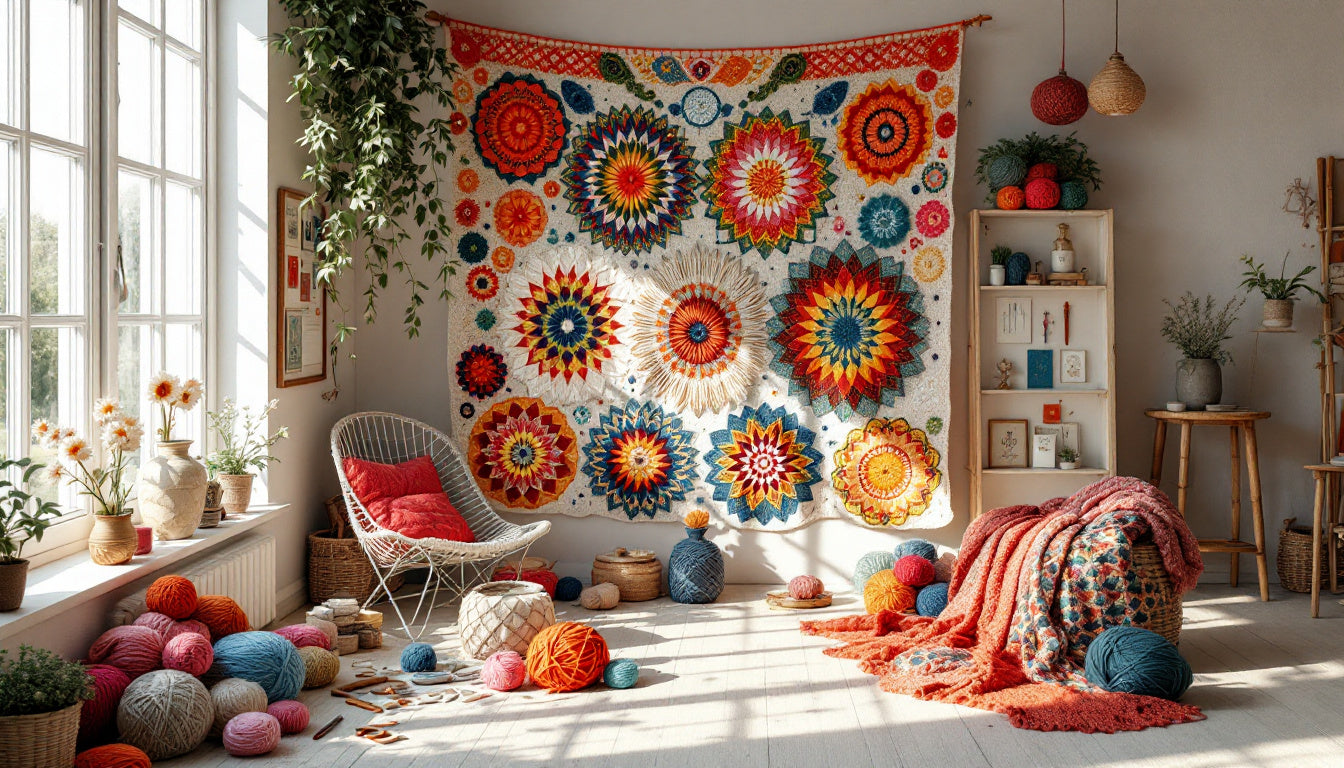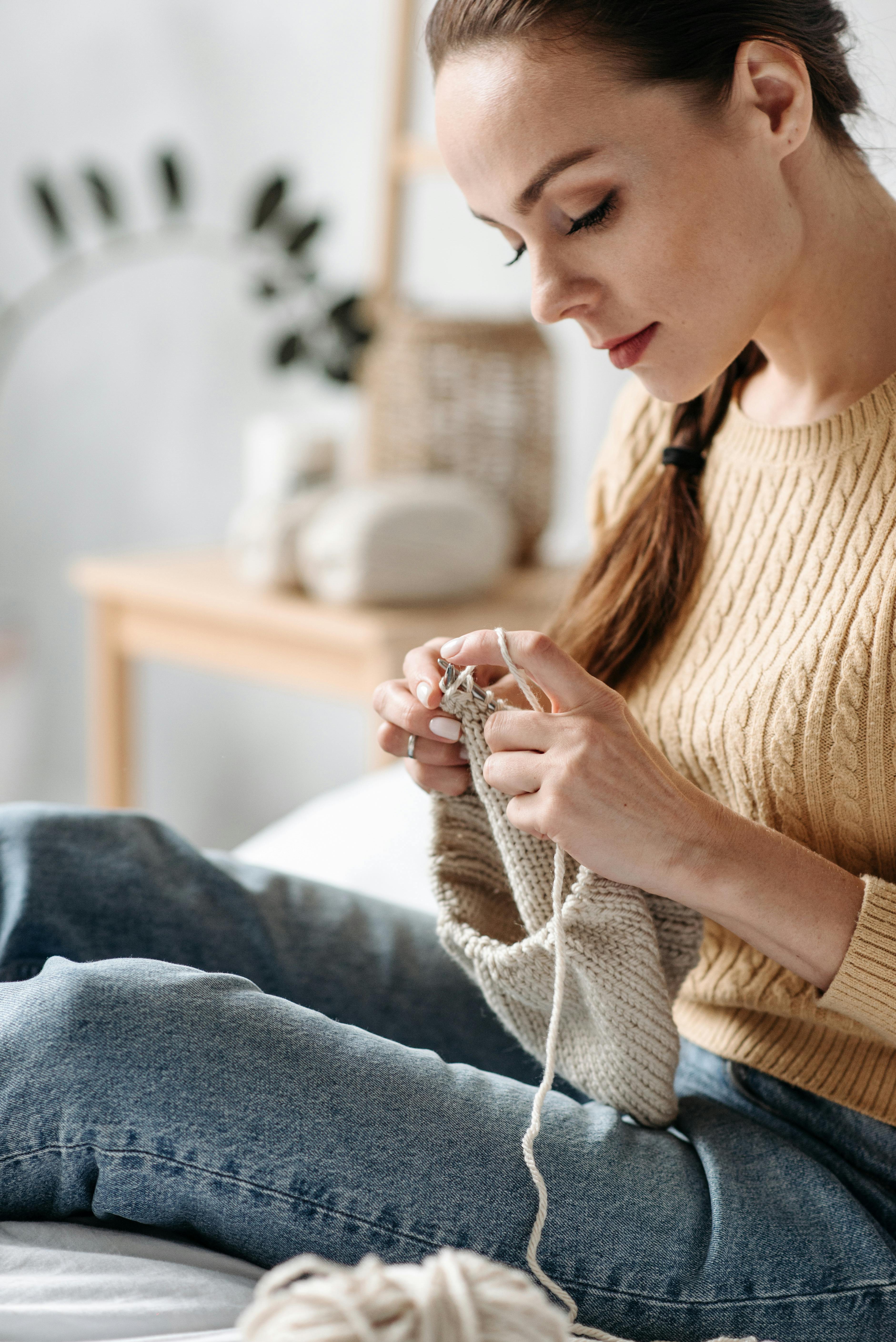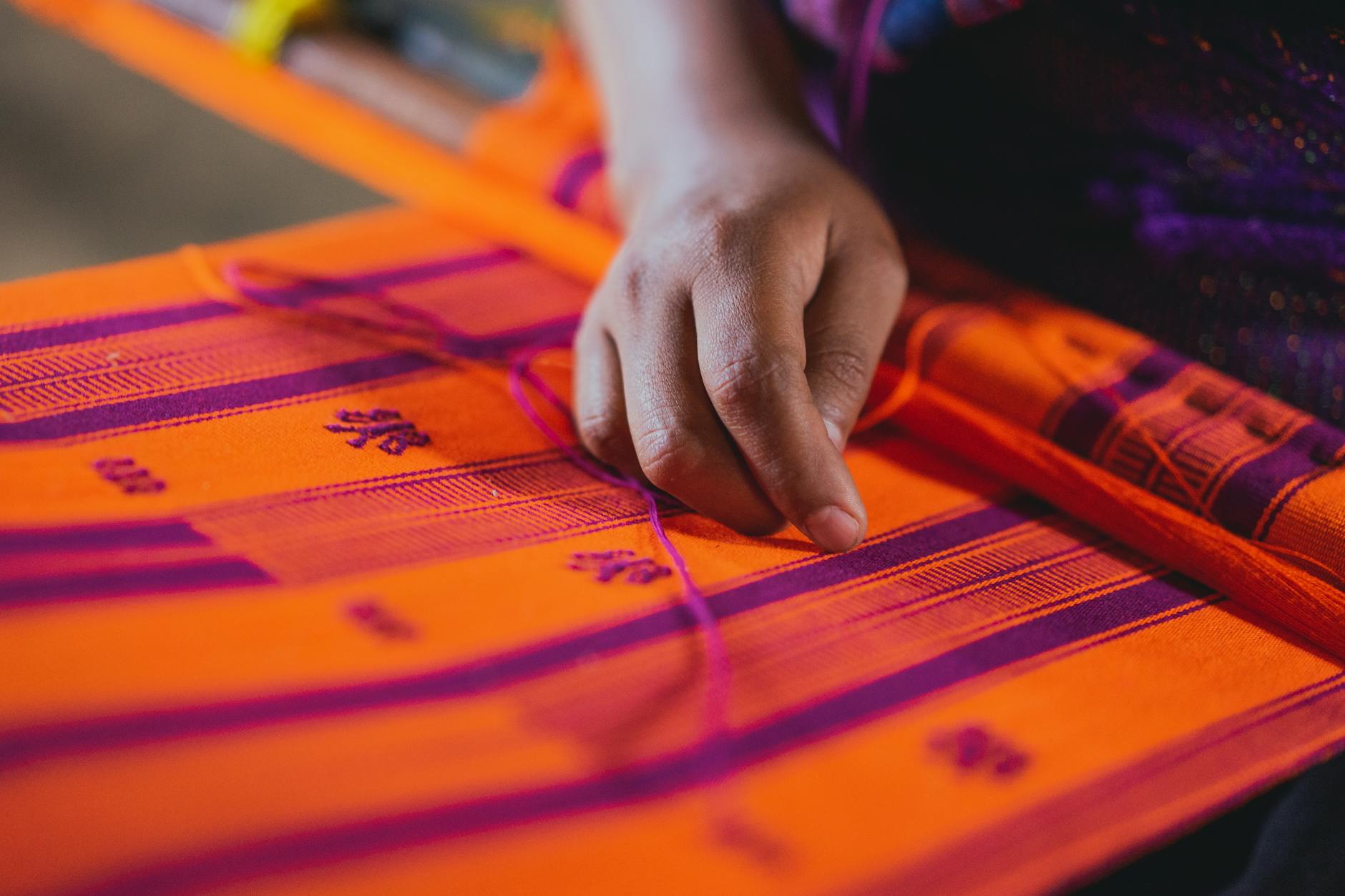
Tracing the History of Crochet: From Ancient Times to Modern Trends
Crochet's origins are as fascinating as they are mysterious, blending ancient techniques with evolving creative trends. While its exact roots are debated, crochet has woven itself through centuries, touching various cultures and traditions along the way. From a practical skill to a modern art form, its journey reflects adaptability and global influence—qualities that still make it so loved today.
Early Needlework Techniques: Foundations of Crochet
Crochet, as we know it today, has centuries of history intricately woven into its fibers. Its evolution is as fascinating as its techniques, shaped by ancient practices and creative innovations. Let’s look at some intriguing early techniques that helped lay the foundations for crochet.
The Role of Shepherd's Knitting

Photo by Castorly Stock
Shepherd’s knitting, also called "single-needle knitting," is often considered a forerunner of modern crochet. Originating in Scotland and Northern Europe, this technique was a practical way to create durable items like nets, sacks, and garments. By using a hooked tool similar to a crochet hook, artisans would create loops in interconnected patterns, much like crochet stitches today.
What sets shepherd’s knitting apart is its employment of simple and repeated motions, making it user-friendly for beginners. Its resemblance to basic single crochet stitches lays a historical bridge, showing how the earliest forms of handcrafting yarn influenced the development of crochet.
Want to try your hand at similar beginner-friendly crochet techniques? Check out our beginner crochet patterns.
Nålebinding and Its Significance
Another ancient craft often mistaken for crochet is nålebinding, or "needle binding." Før med nålebinding (a Scandinavian term) translates roughly to "before knitting," and for good reason—it's thought to predate both knitting and crochet by centuries. This knotless netting technique uses a single needle to create fabric by looping yarn through previously made loops.
While nålebinding produces denser results than crochet, the motion and intent are similar. Both work with yarn to create complex patterns and structures, though nålebinding doesn’t use the familiar hooked tool we associate with crochet. Some of its distinct stitches even inspired modern crochet patterns, proving how interconnected these crafts truly are.
Interested in understanding more about fibers and their historical roots? Sites like the History of Crochet provide detailed insights.
Early Evidence in Arabia and Beyond
Archaeological evidence has traced crochet-like techniques back to ancient Arabia, China, and Israel. Although these methods didn't bear the name "crochet," they exhibit striking similarities. For example, tambour embroidery—a process where a fine hook pulls thread through fabric to create chains—was highly popular in Persia and North Africa before spreading to Europe during the 18th century.
In addition, remnants of knotted nets and textiles from these regions demonstrate designs akin to modern crochet. Many scholars believe these early practices were adaptations of traditional methods, aimed at creating versatile, decorative, or functional items.
Want to explore more intriguing facets of crochet's origins? Check out this history-filled article from the Crochet Guild.
Through practices like shepherd's knitting, nålebinding, and techniques from ancient cultures, we can see how crochet grew into the creative art form that it is today. By revisiting these earlier crafts, we honor the knowledge that paved the way for modern yarn artistry.
Crochet in the 19th Century: Its Rise as a Craft
The 19th century saw crochet emerge from its modest beginnings into a recognized and celebrated craft. This was a period of profound evolution as innovative techniques, patterns, and cultural shifts helped shape its identity. Let's discover how crochet found its footing and became an essential part of the era.
The First Printed Patterns and Tools: Explore how the Netherlands and early tool patents shaped the craft
 Photo by Kaboompics.com
Photo by Kaboompics.com
The 19th century brought the first-ever printed crochet patterns, an innovation that changed the game for crafters. The Dutch publication Penelope in 1824 was among the trailblazers, inspiring countless enthusiasts to explore intricate projects. Before this, crochet was predominantly taught verbally or passed down through demonstrations within families. These publications paved the way for creativity to soar beyond local boundaries.
Around the same time, advances in tools made crochet even more accessible. Patents for hooks, which were often made of wood, bone, or ivory, began to appear, allowing users to experiment with various techniques. Tools became simpler, more ergonomic, and better suited for creating finer and more detailed works.
For those looking to start, embracing classic, simple stitches is still the way to go. You can find plenty of beginner-friendly patterns like those available here.
Irish Crochet and Economic Impact: Discuss how Irish crochet during the Potato Famine provided an income source, showcasing the craft's versatility
Irish crochet emerged during the dire times of the Great Potato Famine in the 1840s. For many families, crochet became more than a pastime—it turned into a lifeline. Women and children, faced with an unforgiving economy, turned to crochet lace to support their families. These intricately crafted pieces often mimicked more expensive needle lace, making them highly marketable throughout Europe and beyond.
What made Irish crochet so adaptable was its versatility. It was portable and required minimal materials—ideal for a time of poverty. Beyond income, crochet provided a creative outlet that preserved a sense of pride and culture in an otherwise dark period of Irish history. To this day, Irish lace is revered for its artistic and cultural significance.
Want to experiment with lacework and other advanced patterns? Check out these crochet patterns for inspiration.
Connection to Tambour Embroidery: Highlight how tambour embroidery influenced early crochet techniques
Before crochet gained its distinct identity, tambour embroidery played a formative role in shaping the craft. Originating in Asia and spreading through Europe in the 18th century, this technique involved using a hooked needle to pull thread through fabric, creating small, decorative loops. Sound familiar? It's essentially the predecessor to modern-day crochet.
Tambour embroidery's influence is most visible in the chain stitch, which forms the basis of many crochet patterns. Early crochet techniques inherited tambour's precision and emphasis on delicate details. The transition from fabric to freehand yarn work was a natural evolution, showing how creativity can leap between mediums.

For deeper insights into crochet's historical rise, this historical article on Victorian crochet sheds further light on its transformation.
The journey of crochet through the 19th century highlights its evolution as not just an art form but also a lifeline and cultural hallmark. Each development, from tools and techniques to its widespread adoption, tells a story of resilience, ingenuity, and creativity.
20th Century Innovations in Crochet
The 20th century marked an exciting time for crochet, as the craft evolved in style and technique, finding relevance in both practical use and high art. Let's take a closer look at some notable crochet innovations from this era.
Introduction of Tunisian Crochet

Photo by betül akyürek
Tunisian crochet, often referred to as a combination of knitting and crochet, brought a fresh aesthetic to the craft in the 20th century. Its unique look — featuring a dense, textured weave — appealed to those who wanted to create items like scarves, blankets, and even jackets with a different flair.
This technique uses a special hook, often longer than a standard crochet hook, to retain multiple loops at a time. As a result, Tunisian crochet offers a fabric-like texture that is both sturdy and distinct. Thanks to these properties, it allowed crafters to expand their possibilities, fusing practicality with beauty.
Want to give it a try? Read more about this fascinating technique in Unlock Your Creativity with the Tunisian Crochet Stitch Dictionary.
Filet Crochet and Its Cultural Importance
Filet crochet made a significant impact during this period, particularly from a decorative perspective. Known for its creation of intricate lace-like designs, filet crochet was widely used to make tablecloths, curtains, doilies, and other household accents. Think of it as the craft that brought art to functional home decor.
What makes filet crochet so unique is its ability to create patterns using a grid-like structure of solid and open blocks. These patterns often reflected traditional or cultural motifs, adding a layer of storytelling to everyday items. Imagine hosting a tea party where your table runner itself holds a piece of history—a small but meaningful way crochet worked its magic.

If you're curious about the history and impact of filet crochet, take a look at Discover the Secret History of Crochet.
Crochet Meets High Fashion
Perhaps one of the most exciting developments was crochet’s entry into the world of high fashion. By the early 20th century, designers began incorporating crochet into haute couture, crafting elegant garments and accessories that caught the attention of mainstream markets. From delicate lace gloves to intricate handbags, crochet was no longer confined to home crafts—it was stepping onto fashion runways.
During the 1920s and 1930s, crochet evolved into a status symbol, used in everything from trims on silk blouses to entirely crocheted flapper dresses. Its versatility, portability, and low-cost nature made it particularly appealing to both designers and wearers alike. Crochet was appreciated not only for its function but also for its art, becoming a staple in wardrobes across the world.

If you'd like to explore stylish crochet ideas, check out Free Patterns Tagged "Crochet Fashion".
The 20th century was a pivotal era for crochet, proving that this craft was much more than a means to create practical items. It was—and continues to be—a source of innovation, aesthetic appeal, and cultural significance.
The Modern Era of Crochet: 21st Century Resurgence
In recent years, crochet has found new life in the digital and creative spaces of the 21st century. It’s no longer confined to the realm of crafting or stereotypical “granny hobbies.” With the rise of online communities, dynamic uses like yarn bombing, and endorsements from influential figures, crochet is flourishing like never before. Here’s a look at how this age-old craft is thriving in the modern era.
Online Communities and Accessibility
The internet has revolutionized just about everything, including crochet. Today, online platforms play a huge role in bringing crochet to millions of people. From forums and Facebook groups to Instagram hashtags and Pinterest boards, crochet enthusiasts have countless ways to connect. Platforms like Ravelry and even YouTube tutorials enable people to share patterns, discover new techniques, and gain inspiration.
What’s great about this is how it’s made crochet accessible for beginners and seasoned crafters alike. No longer do you have to rely on handwritten instructions from a family member or a hard-to-find book. You can learn everything from the basics to advanced techniques with a quick search.

For instance, Christa from The Secret Yarnery shares beginner-friendly tutorials and adaptative approaches to crochet that break down intimidating barriers for newbies. Explore some great crochet pattern ideas to see how you can get started or grow your skill set.
The Role of Celebrities and Influential Figures
Ever notice when a celebrity wears a crochet dress, it seems to set a trend? Famous personalities like Harry Styles, who proudly donned a colorful crocheted cardigan during a performance, have significantly contributed to the resurgence of crochet. These modern-day “style goals” make the craft seem chic, cool, and something worth trying.
Beyond fashion, many influencers and creators on social media platforms have embraced crochet as a form of expression and creativity. Gen Z especially has taken to crochet as a way to explore individuality and sustainability. A recent article discusses just how trendy and identity-driven this movement has become.
Crochet’s rise in celebrity culture and fashion shows that it’s not just a craft confined to utility—it’s also a statement.
Yarn Bombing and Artistic Expression

Photo by Andrei M. S.
One of the most colorful and unique applications of crochet is yarn bombing. This practice transforms dull urban spaces into vibrant, artistic wonders using yarn. Streets lined with crocheted lamp posts or trees wrapped in colorful afghans breathe personality into an area. It’s a community-focused form of art that melds tradition with innovation.
What’s fantastic about yarn bombing is the way it brings people together. Participants in these projects often work collaboratively, reflecting shared creativity and neighborhood pride. Plus, it’s a fun blend of crochet's decorative roots and the modern drive for public art!
If you’re curious about how others are using yarn creatively, check out the “Changing Colors” tips here to add flair to your own projects.
From celebrities hyping its charm to the grassroots authenticity of yarn bombing, crochet has definitively become a force within both art and fashion. Modern accessibility only strengthens its appeal, inviting people of all generations to pick up a hook and start stitching. It’s never been easier—or trendier—to be a part of this creative movement!
The Cultural and Personal Impact of Crochet
Crochet goes beyond being just a fiber art or a hobby. It's a creative tradition that bridges personal expression and cultural legacy while offering practical, emotional, and community support. Let's delve deeper into its powerful role in our lives.
Crochet as a Creative Outlet

Photo by Ayşenur
Crochet serves as more than just an artistic activity; it's often a sanctuary for the mind. Engaging in the rhythmic loops and repetitive motions provides a therapeutic escape, acting as a form of meditation in motion. Studies have found that crafting, including crochet, can reduce stress and improve mental clarity by keeping hands busy and minds focused on creating something tangible.
But the beauty of crochet is its capacity for self-expression. Each project reflects the maker's personality, whether it's through vibrant color palettes, intricate lace-like patterns, or everyday practical designs. If you're a beginner looking to explore crochet as a new creative outlet, take a look at simple yet stunning patterns to get started.
Have you ever noticed how working with yarn creates a calming sense of purpose? It's no wonder many compare crochet to knitting or even painting; every stitch feels intentional and uniquely yours.
For more on how crochet fosters personal well-being, check out Crafting Calm: Unraveling the Benefits of Crochet. It's fascinating to see how crochet is linked to mental health and happiness.
Economic Benefits of Crochet
Historically, and to this day, crochet has provided economic opportunities for individuals and communities alike. From vibrant markets in the developing world to side hustles by stay-at-home parents, crochet transforms creativity into income.
For instance, Irish women in the 19th century used crochet to earn a living during the nation's devastating Potato Famine. This tradition of creating and selling handmade items has carried forward globally. Today, marketplaces like Etsy and community fairs celebrate crochet as both art and livelihood. Want to try your hand at a beginner-friendly piece that could one day turn into a business? Explore this crochet sweater pattern for inspiration.
On a community level, crochet groups often band together to donate or sell projects, earning money for local causes or charities. These efforts blend economic impact with community-building, highlighting how crochet is more than just an individual creative pursuit.
Curious how crochet intertwines with sustainability? Read more in The Timeless Allure of Crochet for an eye-opening perspective.
Crochet's cultural and personal impact is undeniable. It's a craft that nurtures the human spirit, brings communities together, and empowers both personal and economic freedom. Whether stitching for joy or profit, there's magic in every loop.
Preserving Crochet's Heritage While Innovating
Crochet is one of the most dynamic crafts, where history meets creativity. Its rich background, etched in traditions, is a treasure worth protecting. At the same time, experimenting with crochet today has redefined its limits, making it relevant across industries. Let’s explore how preserving its heritage and opening doors to innovation keeps crochet thriving.
Conserving Patterns and Techniques

Photo by Los Muertos Crew
Crochet’s story would be incomplete without efforts to retain the patterns and techniques that have stood the test of time. Traditional methods, passed down through generations, hold cultural footprints that transcend borders. For example, Irish crochet lace, born out of necessity during the Great Potato Famine, is now famously admired for its intricate details and history-filled motifs.
Many organizations and individuals work to digitally archive old patterns and restore pattern books, ensuring that the art form's roots continue to inspire. Keeping these records is essential for celebrating crochet’s authenticity and connecting modern users to its past.
Have you ever thought about including vintage-inspired pieces in your projects? These efforts are not just about memory—they expand your possibilities in crochet. Explore ideas like home decor crochet patterns for fresh ways to honor tradition.
For a broader perspective, check out Preserving the Craft: Keeping Hand Crochet Alive, which emphasizes conserving crochet’s cultural roots while embracing artistry today.
Pushing the Boundaries of Crochet
Crochet is no longer just about creating useful household items. Today, it’s a medium for avant-garde fashion, groundbreaking art pieces, and even unexpected uses like medical technology. Think of 3D sculptures made entirely through crochet, or experimental dresses seen on international runways—just a taste of what the craft can offer.
Projects like yarn bombing, or street art crafted from crocheted pieces, signify that crochet is breaking out of the home and into public spaces. It’s art, activism, and a dash of whimsy rolled into one.
Moreover, fashion designers incorporate crochet into modern wardrobes through bold and edgy designs. This blending of creativity and utility proves that crochet evolves while staying timeless. If you'd like to explore exciting modern projects, dive into the Cozy Cardi pattern for beginners for wearable experiments.
For more on how tradition and innovation mix, visit Unraveling the Threads of Our Heritage, which explores heritage-driven yet modern crochet initiatives.
Crochet bridges past and future with its versatility—a rare balance not many crafts manage to achieve. It reminds us why preserving history is as vital as pushing creative boundaries.
Conclusion
The journey of crochet, stretching from its mysterious origins to its thriving global popularity today, is nothing short of inspiring. Whether it traces back to ancient Arabia, evolves through shepherd's knitting and nålebinding, or flourishes during Ireland’s economic hardships, crochet consistently reflects creativity, adaptability, and timeless beauty.
Now, modern communities are redefining the craft, blending heritage with innovation. You're invited to be part of this vibrant global movement. Explore patterns, techniques, and connect with like-minded enthusiasts through our crochet resources. Or dive into interactive tutorials and discussions on our YouTube channel.
Let the rich legacy of crochet inspire your next stitches!
FAQs
1. Where did crochet originate?
Crochet’s exact origins are debated, but techniques resembling crochet have been found in ancient Arabia, China, and early European cultures. Methods such as tambour embroidery and nålebinding are closely related and likely influenced its development.
2. How is crochet different from knitting?
The primary difference is the tool and technique: crochet uses a single hook, while knitting uses two needles. Crochet stitches are created one at a time and locked in place, making it less likely to unravel compared to knitting’s continuous loops.
3. What is shepherd's knitting, and how does it relate to crochet?
Shepherd’s knitting, also called "single-needle knitting," is an early technique that uses a hooked tool to create loops. It’s considered a predecessor to modern crochet as the methods resemble single crochet stitches.
4. What role did crochet play during the Irish Potato Famine?
During the 1840s, Irish women and children used crochet to create lace for income. The demand for Irish lace helped many families financially survive the famine, making crochet an economic lifeline.
5. Why is tambour embroidery important to crochet history?
Tambour embroidery used a fine hook to pull thread through fabric, forming chains. This technique heavily influenced early crochet styles and stitches, laying the foundation for the craft as we know it.
6. What is Tunisian crochet, and how is it different from traditional crochet?
Tunisian crochet uses a longer hook and retains multiple stitches on the hook, resembling a mix of knitting and crochet. It creates a dense, woven-like fabric with unique textures.
7. How has crochet influenced modern fashion?
Crochet has entered high fashion, from 1920s flapper dresses to today’s designer pieces. It’s often used for chic accessories, bold textures, and unique garments on runways and in mainstream fashion.
8. What is yarn bombing?
Yarn bombing is a form of street art where public spaces are covered with crochet or knit pieces. It transforms urban areas with vibrant displays and highlights crochet as a medium for creative expression.
9. How has the internet impacted the crochet community?
The internet has made crochet highly accessible through tutorials, forums, and pattern-sharing platforms like Ravelry and Pinterest. These communities empower people to learn and advance their crochet skills from anywhere.
10. What makes crochet a sustainable craft?
Crochet is sustainable because it encourages the use of long-lasting handmade items. Many crafters also use recycled or eco-friendly yarn, creating pieces that are environmentally conscious and reusable.
11. Can beginners learn crochet easily?
Yes, crochet is relatively easy to learn, especially with online tutorials, beginner-friendly patterns, and simple stitches like the chain stitch or single crochet. It’s a great craft for all skill levels.
Christa Patel is a passionate crochet enthusiast, designer, and content creator with over a decade of experience in fiber arts. Known for her engaging tutorials and innovative designs, Christa shares her love for crochet through her popular platform, The Secret Yarnery.
Her journey into crochet began as a creative escape, and it quickly transformed into a full-time endeavor where she encourages others to embrace the joy of handmade artistry. From beginner-friendly tutorials to advanced patterns, Christa inspires crocheters of all skill levels to explore their potential.
In addition to her work in design and teaching, she has dedicated herself to preserving crochet’s rich heritage while pushing the boundaries of yarn art. Christa’s aim is to make crochet accessible, modern, and fun for people around the world.
When she’s not crafting with yarn, Christa enjoys connecting with her community through interactive workshops, sharing helpful resources, and encouraging creativity in all forms. Explore her inspirational world of crochet through her website The Secret Yarnery or join the conversation on her vibrant YouTube channel.
Whether you're just starting your first chain stitch or creating intricate lacework designs, Christa believes crochet is a craft that can bring joy, connection, and limitless artistic possibilities.


